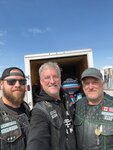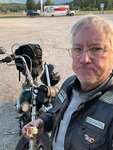


Motorcycles have been a part of Dr. Don Chaffer’s life for as long as he can remember. From long-distance rides to rebuilding old engines, Chaffer says he is not one to leave a goal unaccomplished.
In August, Chaffer tested his physical and mental endurance by facing one of his toughest rides yet – a 10,000-mile journey from Florida to Alaska on a 1948 Harley-Davidson Panhead. During his third attempt to complete the Hoka Hey Motorcycle Challenge, he finally reached his goal of crossing the finish line on his vintage motorcycle.
“It was really inspiring to me,” Chaffer said. “It really was an amazing experience to be able to finish on that old bike, because through the years, it's been a six-year process of trying to accomplish that goal.”
Riding long-distance on an older motorcycle comes with a variety of mechanical risks, which Chaffer experienced during his previous attempts at Hoka Hey. In 2020, his bike broke down halfway through the route and he could not complete the challenge. Although he eventually crossed the finish line in 2022, the engine on the bike blew on the first day, forcing him to complete the challenge on a modern motorcycle.
Chaffer spent two years working on the Harley to get it ready for 2024’s challenge. “Mechanically, I felt like it was my best shot at getting the vintage bike across the finish line,” he said.
Chaffer spent 17 days on the road before crossing the finish line in Alaska. He left Daytona Beach, Florida during the early morning hours of Aug. 4 and finished in Alaska on Aug. 20. His goal was to ride for at least 20 hours.
However, there were moments when it seemed like the motorcycle would not make it all the way to Alaska. When Hurricane Debby made landfall in Florida, Chaffer found himself riding for multiple days in the rain.
“It really was by far the toughest Hoka Hey route, I think, that we've had maybe since the first Hoka Hey,” Chaffer said. “It was a very challenging set of circumstances, too, because the ride started in Daytona, Florida, and the route took us to Key West, the most southern spot in the United States, and back up through Florida. By the time we got out of Florida, we'd already had well over 1,100 miles on our bikes, and we started off in Hurricane Debby.”
Without the hands-on help of others and the support from the community, Chaffer believes he would not have accomplished his goal. While riding through a national park in Alberta, Canada, Chaffer shares that he had to ride for nearly 45 miles off route to receive help after his handlebars broke in half. One of his friends in the motorcycle community, Robert "Grizz" Bennett, connected him with a local motorcycle shop where he could receive parts and repair his bike.
“I was able to finish, because even though it was the hardest route maybe in Hoka Hey history, and even though it was on a motorcycle that nobody had done it (on) before, it wasn't accomplishable by myself. It was a community thing,” Chaffer said.
Chaffer said each motorcycle contains a satellite tracker, so his friends and family could follow his progress and share their encouragement.
“I had a lot of things on the motorcycle that weren't working by the time I crossed the finish line,” Chaffer said. “But once I crossed that border of Alaska, the energy just went through the roof. People started getting really excited about it, because a lot of folks said it couldn't be done, and then a lot of people just really wanted it to be done.”
Chaffer said he first bought the vintage Harley about 15 years ago and rebuilt it alongside one of his best friends who passed away last year. This experience also inspired his determination to finish the ride.
“We did it together, building the bike for 2020 and 2022,” he said. “When he passed away this past October, it just really became all the more important in the spirit of our friendship to finish that goal.”
Chaffer said he is one of the first riders to complete the Hoka Hey challenge on a vintage motorcycle. He adds that there is one other rider, Abby Spaedt, who also attempted to complete the challenge on a vintage motorcycle. They made it approximately 7,000 miles into the route in 2022.
“She and I have remained in contact through all of this. She was really excited for this year – for me crossing the finish line,” Chaffer said.
Hoka Hey takes place every other year, offering an endurance-challenging ride that covers thousands of miles of diverse terrains across North America. Jim Red Cloud, who died in 2017, founded the first Hoka Hey challenge in 2010 as a symbol of the “warrior spirit.” The 2024 route pays homage to 2010’s inaugural ride that began in Key West, Florida and ended in Homer, Alaska.
During the challenge, Chaffer explains that riders do not follow a GPS or any sort of navigation aids, but instead use a pre-mapped route that contains various checkpoints. Since riders are tracked in real time, the organizers can notify them if they steer off course. The challenge attempts to limit the use of interstates, and instead takes riders mostly through secondary paved roads.
Hoka Hey also asks riders to camp near their bikes at all times to receive finisher recognition. Since this excludes staying in hotels, riders often carry a tent or hammock. Because Chaffer has limited room on his vintage bike, he said he opts to sleep outside in public places with an overhang or shelter.
Hoka Hey doesn’t consider the challenge as a race and discourages “placing” riders, Chaffer explains. The organization presents a special award for a rider who raises the most money for a chosen charity as well as honors four riders who demonstrate respect, honor, integrity, and passion, according to the Hoka Hey website.
“Really what they want is (for) all riders to finish,” Chaffer said. “Finishing represents an equal victory for everybody. However long it takes you, you're riding against yourself. You're not riding for a place.”
Along with presenting an intense challenge for riders, Hoka Hey also aims to raise awareness for social issues that impact the country. In 2024’s challenge, Hoka Hey partnered with the Kenaitze Indian Tribe to raise money for their Yaghanen Language and Cultural programs.
Due to the nature of the challenge, Hoka Hey only accepts a limited group of experienced riders. While returning riders are always welcome, the organization places a limit on new riders. This year, approximately 200 riders participated in the challenge.
After the challenge, Chaffer loaded the motorcycle into a truck that he drove all the way back to Texas.
Chaffer also rides in other long-distance challenges, such as Mile Monsters Inc., an organization that raises money and awareness for youth diagnosed with Duchenne Muscular Dystrophy. When Chaffer is not participating in a long-distance ride or working on his motorcycle, he serves as a nephrologist at Coryell Health in Gatesville.
“Though 2020 and 2022 weren't failures completely, they just weren't accomplishments of the goal as intended, and that's to get that old motorcycle across the finish line, me and the bike together,” Chaffer said.